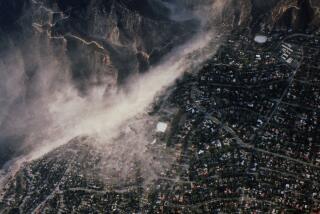Communications Gap
“We interrupt this program . . .”
Everyone has heard the tests of the emergency broadcast system on the radio from time to time. But when it was needed most, during the Oct. 17 earthquake in Northern California, there was not much interrupting by the emergency network and precious little information given out to disaster victims when the system did function.
Finally, two hours after the quake struck, a message from San Francisco Mayor Art Agnos appealing for calm was broadcast. But some stations did not even bother to tune in to the system, much less carry its information. Others said they were getting better information from their own reporters. A major problem seems to have been that officials had trouble gathering up-to-date information and transmitting it via the official network, according to a review of quake communications problems by Joel Kugelmass, a telecommunications management analyst, in the Sacramento Bee.
As it turned out, the failure of EBS was not a major problem because local radio and television stations were able to broadcast information relatively quickly. That might not have been had the quake been stronger, or lasted a few seconds longer.
Much of the early information, on an official areawide level, came from Dan Rather interviews on CBS News with Lt. Gov. Leo T. McCarthy, who was acting governor because Gov. George Deukmejian was in Europe at the time. McCarthy’s reports were cautious and calming, but relatively incomplete during the evening because of difficulty in getting information from such isolated areas as Watsonville and Santa Cruz, and even San Jose. Early Wednesday, McCarthy began telephoning a variety of news media outlets to distribute as much authentic information as was available.
As good as the broadcast news reports may have been, the problem for listeners and viewerswas that they had no central broadcast point from which to receive the latest, most comprehensive information from official sources. The Emergency Broadcast System is supposed to be that central point.
Some local emergency communications systems seemed to work well, but they are meant for public agencies to talk to each other. The telephone system remained in operation and, although it was immediately overwhelmed with calls, emergency messages were given priority and got through after some delay. The major breakdown was in getting official information directly from the officials to the people. “We talked to the whole world,” one Oakland official said, while another office was in constant communication with one talk radio station. But an earthquake victim should not have to keep scanning the dial to get critical information.
The emergency system is a volunteer operation supervised by the Federal Communications Commission. The FCC presumably will evaluate the quake-night performance and possibly make improvements. But the state of California should not wait for that to happen. California officials must make it a priority to have as foolproof as possible a system of emergency communications with the public in future disasters, especially earthquakes. This must include equipment that can go into operation quickly, by satellite transmission if necessary. It also must have public officials available who have ready access to local, regional, state and federal sources of information and can get it on the air without delay.
As noted by Assemblywoman Delaine Eastin (D-Union City), “It’s time to stop thinking of communications as an expense and start thinking of it as an investment in the health and safety of Californians.”
Californians may be left in the dark during the first terrifying hours of an earthquake disaster. But they should not be left ignorant of what is going on as well.
More to Read
Sign up for Essential California
The most important California stories and recommendations in your inbox every morning.
You may occasionally receive promotional content from the Los Angeles Times.










